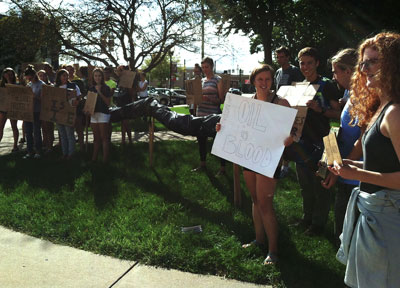In an effort to end Goshen College’s investment in oil companies, Hannah Yoder, a junior, and Cecilia Lapp-Stoltzfus, a senior, conducted research over the summer regarding Goshen’s divestment progress.
Lapp-Stoltzfus and Yoder wrote an extensive literature review as an educational resource and consolidation of GC Divest ideas. This review was done for Goshen College and the Mennonite Education Agency’s (MEA) Investment Fund Committee. Ken Newbold, provost, and Glenn Gilbert, Goshen’s sustainability coordinator, consulted the two throughout the project.Three years ago, conversations began within GC Divest, a student-led group committed to ending Goshen’s investment in fossil fuels. As Lapp-Stoltzfus and Yoder approached the spring of 2016, their motivation for continuing the campaign for divestment increased.
Divestment refers to Goshen College’s endowment, which functions as a large savings account built up by donors. This pool of money has been invested primarily in stocks and bonds, including large oil companies that are harvesting fossil fuels around the world.
As a first-year in 2013, Lapp-Stoltzfus had interest in furthering the divestment conversation on campus. She joined GC Divest and later became a leader of EcoPAX, a student-led group focused on environmental stewardship and sustainability.
Yoder found herself interested in divestment as well.
“In the spring of my freshman year,” Yoder said, “EcoPAX and GC Divest were writing this big divestment proposal. I showed up to one of their meetings and started writing different sections of it, and then just stayed connected from there.”
Goshen College’s endowment is pooled with 21 different organizations, all managed under MEA. These organizations include the likes of Eastern Mennonite University and Bluffton University. Also included are high schools such as Bethany Christian, Central Christian, Freeman Academy and Iowa Mennonite.
“Over the past few years,” Newbold said, “the Ecological Stewardship Committee has been discussing the topics of divestment and socially-responsible investing. So when Hannah and Cecilia proposed doing a literature review that would begin to survey scholarly sources on the subject, it seemed like a logical next-step in our work to better understand the complexities of the issue.”
This conversation is not happening solely at GC.
“There’s a lot of national conversation about fossil fuel divestment,” said Lapp-Stoltzfus. “Within GC Divest, we began to realize that GC’s endowment [was] unique.”
As the project developed, the writing was catered toward the MEA, an avenue through which endowment could change. To see the project through, the two applied for grants through GC’s Ecological Stewardship Committee and the MEA.
As a member of the committee, Newbold represents financial interactions for GC. After hearing the proposal, Newbold and Gilbert agreed to work with the development of the literature review.
While Yoder and Lapp-Stoltzfus oversaw the majority of their writing during the summer, Lisa Heinz, senior director of operations and chief financial officer of MEA, and Mark Reiger, representing Everence Federal Credit Union, helped them prepare for their initial goal of presenting to the MEA Investment Fund Committee.
During the summer months, Yoder and Lapp-Stoltzfus did most of the work nearly 600 miles apart from each other, working and communicating primarily through a Google document. While Yoder stayed in Goshen studying nursing, Lapp-Stoltzfus was in Washington DC at an internship in her hometown.
After meeting with the committee in early September, Yoder and Lapp-Stoltzfus have been working to polish their work.
“In writing [the review], we hoped that the MEA investment committee would find our [research] educational and helpful,” said Lapp-Stoltzfus. “We also envisioned [the review] being informative for students who are involved and for discussions surrounding endowments.”
Lapp-Stoltzfus and Yoder are looking forward to the arrival of Mark Campanale, the founder of the Carbon Tracker Initiative. He is coming to campus on Oct. 2 and 3 to speak on carbon usage in the future. His name is widely known around the divestment conversation, giving the two a unique perspective on their literature review.
Beyond the Goshen College campus, the two students are hopeful that the writing will reach many. With Newbold’s help, the literature review may be published in student research journals.
Their goal is to have the review appear on 350.org. The 350.org website is a non-profit organization that was derived from Middlebury College in Vermont and functions as a “global network of climate change activities.” Setting the stage for fossil fuel divestment, this platform has the potential to reach activists around the world.


